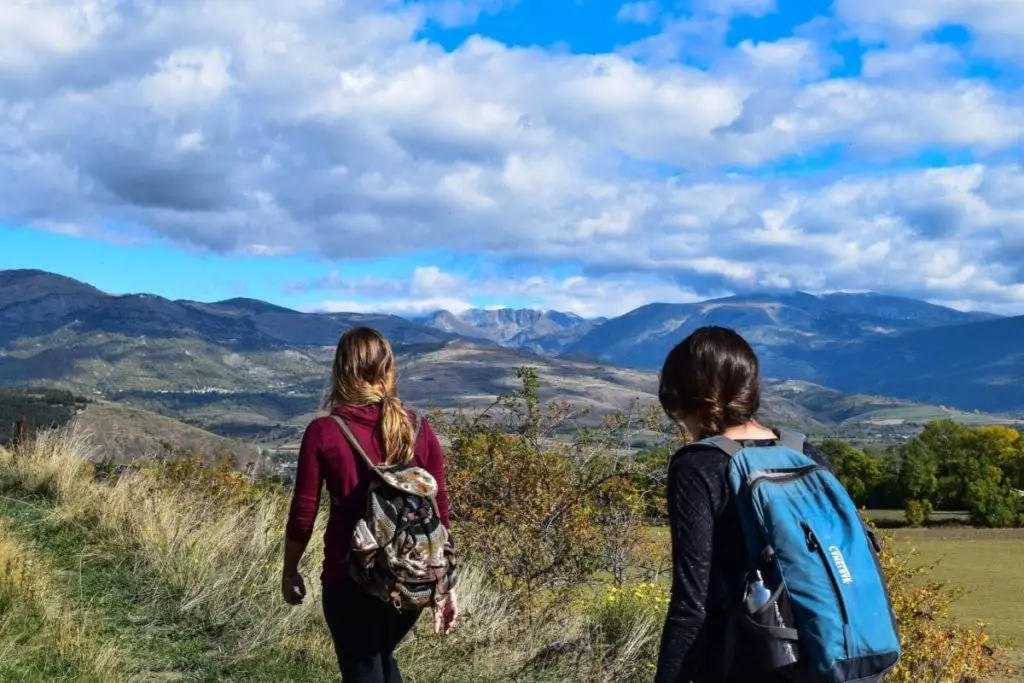We may earn money or products from the companies mentioned in this post.
Hiking Training
Hiking training lets you prepare for your hike. When prepared, you can endure the hike’s challenges.
Training prepares you to meet the challenge of carrying a pack that weighs 10 pounds, 20 pounds, or even more as you hike. You need strength paired with cardiovascular fitness so you can enjoy your hike.

Be sure you have the exercise equipment you need to build cardiovascular (cardio) stamina and muscle strength. Also, be sure you have the best gear from boots to backpack to have an enjoyable hike.
Make a Hiking Training Schedule

If you have a goal to complete a three to a five day backpacking journey, you want to prepare by keeping a regular cardio training schedule. Work out with high intensity cardiovascular sessions and enough resistance exercises that you build endurance and muscles.
Assume that you have average health and fitness. Check with your doctor before you begin your training program. Plan for 6 to 8 weeks of training before you hike.
Hiking Training for Your Heart
If you want to hike 10 or even more miles a day, plan at least 3 days of cardio training before you hike. Modest, steady exertion is crucial. You need enough cardio training to allow you to maintain a constant pace as you hike.
How Long
Your cardio exercises need to last 30 to 60 minutes. Switch your exercises between walking, hiking, and biking. Switching allows you to avoid injuries caused by repetition.
Try Interval Training
If you do 5 days of cardiovascular exercise, include 2 high intensity exercise sessions. These sessions focus on improving your hiking speed and hiking steeper paths.
Begin your interval exercises with a 5 minute, moderate intensity workout. As you hike, bike, or walk, increase your pace as much as possible. You want to be working out at your highest level for a short period of time.
Intervals need to consist of 30 to 90 seconds of a high intensity exercise followed by a light to moderate recovery period of up to two minutes. Continue this work/recovery balance for 20 to 40 minutes. End up your exercise with a complete cool down.
Training Hikes
In the months leading up to your trip, try to do a day hike at least every other week. These hikes build your cardio fitness and help you get used to wearing your backpack while hiking.
Gradually, take longer and steeper hikes. Also, increase the weight in your pack. This allows you to be prepared for longer more strenuous hikes.

These hikes let you become used to your hiking gear. The hikes also help you decide what clothing is most comfortable and suitable for your hikes.
Resistance Exercise
When you hike, you encounter a variety of terrain including rocky trails, steep trails, etc. Your backpack’s weight increases your center of mass and strains your muscles. Resistance training prepares your body for the stability challenges and impacts of hiking on uneven terrain.
How Often
During your hiking training routine, include at least two days of resistance training in addition to your cardio workouts. You can complete your resistance exercises and cardio exercises on the same day.
Be sure to do your resistance workout first so you are not too tired for these exercises. Do your interval exercises and strength workouts on the same days.
Be sure to do a 5 to 10 minute workout prior to your resistance training workout. The workout needs to consist of 2 to 5 minutes of light cardio activity along with 2 to 5 minutes of vigorous stretching.
Step Ups
Use a 12 to 24 inch step platform or a step around your house. Repeat for 10 to 20 reps on each side for at least 3 sets.
- Stand just in front of the step with your feet about shoulder width apart.
- Place your arms down by your sides or on your hips.
- Using a steady controlled motion, step up onto the step with one leg.
- Pause for a moment with both feet on the step.
- Step down off the step with your opposite foot. Follow with the other foot.
- Return to the starting position.
- Repeat the step. Alternate the leading leg each time.
- Repeat for a total of 10 to 20 times per leg.
Heel Downs
Use a 12 to 24 inch step platform or a step around your house. Repeat for 10 to 20 reps with each leg for at least 3 sets.

- Let one foot hang off the side.
- Bend your free foot (toes lifted up) as well as lower it to the flooring.
- Press your hips back.
- Control the exercise letting your heel hover in the air before returning to the beginning placement.
Crunches
Building your core strength helps you keep your balance on uneven trails. Work your way up to at least 3 sets of 50.

- Lie on your back with your knees bent and feet flat on the floor, hip width apart.
- Place your hands behind your head so your thumbs are behind your ears.
- Do not lace your fingers together.
- Hold your elbows out to the sides but rounded slightly in.
- Tilt your chin slightly, leaving a few inches of space between your chin and your chest.
- Gently pull your abdominals inward.
- Curl up and forward so that your head, neck, and shoulder blades lift off the floor.
- Hold for a moment at the top of the movement and then lower slowly back down.
Squats
Complete 10 to 20 reps for at least 3 sets. Squats exercise your front thigh muscles and hamstring between your hip and knee

CC0, via Wikimedia Commons)
- With your hands on your hips, stand with your feet as wide apart as your hips.
- Put your weight slightly back on your heels.
- Let your arms hang down at your sides.
- Pull your stomach in, and stand tall with square shoulders.
- Sit back and down, like sitting in a chair.
- Lower as far as you can without leaning your upper body more than a few inches forward.
- Once you feel your upper body fold forward over your thighs, straighten your legs and stand back up.
- Do not lock your knees at the top of the movement.
Push ups
Good upper body strength (especially in your back) also helps you on long trips when you need to carry a heavier pack.
- Put your hands directly under your shoulders.
- Keep your feet together.
- Tighten your stomach, and squeeze your butt.
- You need a straight line from the back of your head all the way down through your tailbone.
- As you descend into the push up, keep your elbows pointed back and tucked into your sides.
- When you touch the floor, push hard into the ground, and drive back up into a full lockout position.
Hiking is fun! Often, hiking is strenuous. You want to be in shape when you go hiking, Hiking training prepares you to avoid injury and enjoy your hike.
Pin this for later.

